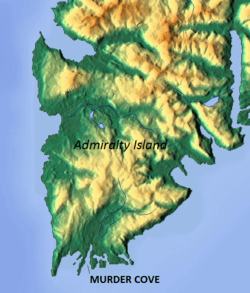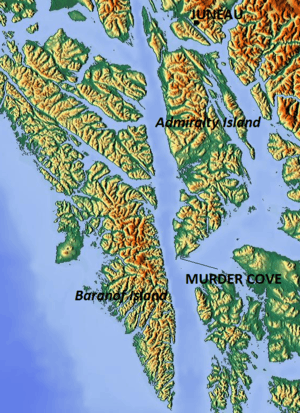Murder Cove
Murder Cove is located at the southernmost portion of Admiralty Island in the U.S. state of Alaska. The cove was home to the Tyee Company whaling station and was known for whaling operations from 1907 through 1913.
Murder Cove | |
|---|---|
Cove | |
.jpeg) Whale at mooring, August 1910 | |
 | |
 Murder Cove Location in Alaska | |
| Coordinates: 57°01′45″N 134°33′20″W | |
| Country | United States |
| State | Alaska |
| Time zone | UTC-9 (Alaska (AKST)) |
| • Summer (DST) | UTC-8 (AKDT) |
History
Name
The area was named Murder Cove after two gold prospectors were murdered in the area in 1869 as revenge for the killing of two Tlingit tribesmen.[1] In retaliation the USS Saginaw destroyed three villages and two wooden forts near present-day Kake, Alaska.[2][3] This fighting between the Tlingit and the US Government became known as the Kake War.
Whaling
.jpeg)
.jpeg)
.jpeg)
.jpeg)
.jpeg)
.jpeg)
.jpeg)
Commercial operations in fishing and sea hunting were established inside the bay at Point Gardner by the Tyee Company who sought to take advantage of the unexploited waters of southeast Alaska.[1][4] They established their operations on Admiralty Island at Murder Cove in 1907 using the first American-built steam-powered whaler, the 97-foot "Tyee Junior", which was equipped with a harpoon gun on the bow. Consequent to a declining whale population, the company closed its operations in 1913.[4][5]
Coal exploration
In 1905, the most extensive coal exploration in southeastern Alaska occurred at Murder Cove, Kootznahoo Inlet, and Hamilton Bay. The Tertiary-aged coal-bearing formations are made up of conglomerate, sandstone, and shale. The Murder Cove explorations occurred on a 5 feet (1.5 m) thick seam located 2 miles (3.2 km) from deep water. Though this deposit contains the best grade of coal in the region, further development did not proceed because of its very limited size.[6] A lighthouse was established at Murder Cover during the fiscal year 1914.[7]
Geography

It forms a narrow inlet 2 miles (3.2 km) in length. Just inside the entrance of the bay are several islands, beyond which the channel contracts to a width of 300 feet (91 m) and then opens to form a sheet of water which at high tide is .5 miles (0.80 km) wide and 1 mile (1.6 km) long. This bay forms a well-protected harbor for vessels of moderate size.[8] At its rocky entrance is the Surprise Harbor, which provides safe anchorage and vistas of the area.[1]
References
- This article contains public domain text from A.C. Spencer's "The Juneau gold belt, Alaska: A reconnaissance of Admiralty Island, Alaska" (1906)
- "Admiralty Island National Monument (Kootznoowoo) Wilderness". The Great Outdoor Recreation Pages (GORP).com. Archived from the original on 3 January 2013. Retrieved 12 January 2013.
- Harring, Sidney L. "The Incorporation of Alaskan Natives Under American Law: United States and Tlingit Sovereignty, 1867-1900." Ariz. L. Rev. 31 (1989): 279.
- “Search for and destroy”: US Army Relations with Alaska’s Tlingit Indians and the Kake War of 1869,” Jones, Zachary R.
- "Murder Cove/Tyee/Surprise Harbor". Backwater.Org. Retrieved 12 January 2013.
- "Alaska's Heritage: Chapter 4-16: Fishing and Sea Hunting". Website of The Alaska History & Cultural Studies. Retrieved 12 January 2013.
- Crider, Albert Foster; Eckel, Edwin Clarence (1906). "Nonmetallic Deposits of Southeastern Alaska". Geology and mineral resources of Mississippi (Public domain ed.). Government Printing Office. pp. 59–. Retrieved 19 January 2013.
- United States. Bureau of Light-Houses (1914). Annual Report of the Commissioner of Light-Houses to the Secretary of Commerce (Public domain ed.). pp. 43–. Retrieved 19 January 2013.
- Spencer, Arthur Coe; Wright, Charles L.; Wright, Charles Will (1906). The Juneau gold belt, Alaska: A reconnaissance of Admiralty Island, Alaska (Public domain ed.). Government Printing Office. pp. 152–. Retrieved 11 January 2013.